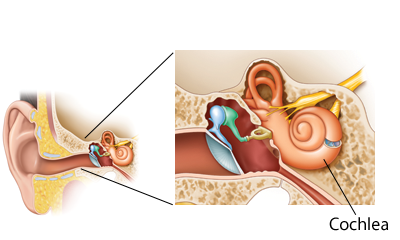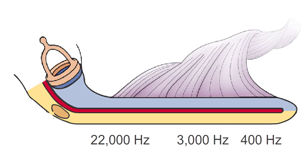Human hearing is most sensitive to sounds from 400 to 5000 Hz, the range of speech. Sound is converted from pressure waves in the air to pressure waves in the fluid of the inner ear. Depending on the frequency of the sound, a membrane in the inner ear vibrates at different positions along its length, stimulating the hair cells at those locations. When stimulated, hair cells produce graded potentials and release a graded amount of neurotransmitter, causing the adjacent sensory neurons to fire action potentials.

Click the Play button and adjust the frequency to see how the basilar membrane responds.







How is the basilar membrane organized?
The physical properties of the basilar membrane gradually change along its length so that high frequency pressure waves are more likely to distort the membrane closer to the oval window, and low frequency pressure waves are more likely to distort the membrane distally.

